more
bridges in France

related Rouen pages
france
new! Cathedrale Saint-Gatien at Tours 
 updated: Romanesque churches and cathedrals in south-west France updated: Romanesque churches and cathedrals in south-west France
the perpendicular or English style of cathedral 
the fire at the cathedral of Notre-Dame de Paris

cathedral giants - Amiens and Beauvais
Stone tracery in church and
cathedral construction 
stone in church and cathedral construction stained glass and cathedrals in Normandy  
fortified churches, mostly in Les Landes
cathedral labyrinths and mazes in France
using metal in gothic cathedral construction
Germans in France
cathedral destruction during the French revolution, subsidiary page to Germans in France

on first arriving in France - driving
France is not England
paying at the péage (toll station)

Transbordeur bridges in France and the world 2: focus on Portugalete, Chicago,
Rochefort-Martrou
Gustave Eiffel’s first work: the Eiffel passerelle, Bordeaux
a fifth bridge coming to Bordeaux: pont Chaban-Delmas, a new vertical lift bridge
France’s western isles: Ile de Ré
France’s western iles: Ile d’Oleron
Ile de France, Paris: in the context of Abelard and of French cathedrals
short biography of Pierre (Peter) Abelard
Marianne - a French national symbol, with French definitive stamps
la Belle Epoque
Grand Palais, Paris


Pic du Midi - observing stars clearly, A64
Carcassonne, A61: world heritage fortified city
Futuroscope
Vulcania
Space City, Toulouse
the French umbrella & Aurillac
50 years old:
Citroën DS
the Citroën 2CV:
a French motoring icon
the forest as seen by Francois Mauriac, and today
Les Landes, places and playtime
roundabout art of Les Landes
Hermès scarves

bastide towns
mardi gras! carnival in Basque country
country life in France: the poultry fair
what a hair cut! m & french pop/rock

Le Tour de France: cycling tactics 

|
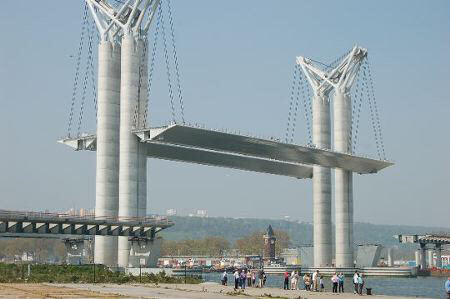
The Pont Gustave Flaubert being
raised for the first time, April 2006.
Image credit: Pierre
Albertini
the
sixth bridge Rouen
is France’s largest river port, as well as being one of
its largest seaports, being 121 km from the open sea. The city
is sited on both sides of a large loop of the River Seine, which
snakes in wide loops on its way through the region of Haute-Normandie
on its way to the English Channel (la Manche). A
new bridge was needed in Rouen to allow traffic coming from the
A150 and A151 to the north-east of Rouen, to reach the port zone
to the west of Rouen and the A13 autoroute to the city’s
south, without having to go through the city centre. The bridge
location chosen ensures that it is the last crossing before the
river flows to the open sea. The bridge serves a similar purpose
to that of the venerable Tower Bridge in London: providing a visit
break between port and city. 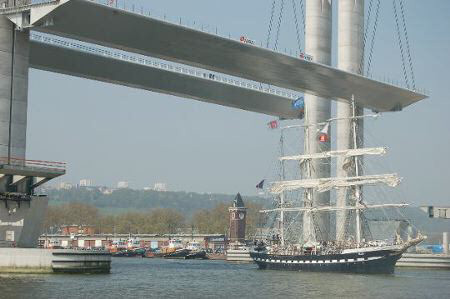
The tall ship, The Belem, passing under
the Pont Gustave Flaubert in April 2007.
Image credit: Pierre
Albertini
Several designs for the
bridge were considered, but only one resolved the constraint that
large (or tall) vessels should continue to be able to approach
the next bridge along towards central Rouen, the Pont
Guillaume le Conquérant - William the Conqueror Bridge.
Every five years, Rouen is host to one of the largest meetings
in the world, the Armada, of the biggest and most beautiful tall
ships - multi-masted sailing vessels. A bridge was required that
would allow these magnificent ships to still be able to reach
the Quays [les quais] alongside the Seine at Rouen. The
new bridge design would also enable full-size cruise liners to
approach Rouen more closely. The location would also provide a
symbolic ‘door’ between the city and its port. The
chosen design - a rising, or vertical lift, bridge - will be the
largest bridge of its type in Europe. The Pont Gustave Flaubert
[Gustave Flaubert Bridge] is due to open to traffic [mis en
service] in the Spring of 2008. The bridge’s name was
chosen after a poll of Rouen inhabitants. In
this vertical lift bridge, the twin roadways are raised and lowered
by heavy steel cables that run over pulleys on the ‘butterfly’
pulley heads that rest at the top of two sets of twin supporting
pylons.
In Bordeaux, on 17 March 2013, a
new vertical lift bridge will be opened.
Pont
Gustave Flaubert, Rouen At the end of 2006,
after polling Rouen inhabitants [who are called Rouennais], a
name was decided for the sixth bridge at Rouen. The sixth bridge
became the Gustave Flaubert Bridge. The actual vote percentages
were - Pont Gustave Flaubert 40 %
- Pont de Rouen
36 %
- Pont Cavelier de la Salle 24 %
Gustave
Flaubert was born at Rouen in December 1821. He was a writer,
his first novel Madame Bovary,
published in 1857, is probably his best known work. He was known
for his particular attention to detail and his quest for chosing
le mot juste - the right word. the
bridges of Rouen 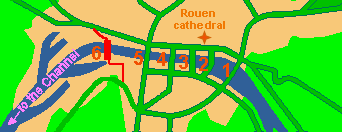
From
inland, the direction of Paris, going towards the English Channel:
- Pont Mathilde - Mathilde Bridge, 1979. 585 metres long, it
passes over the Lacroix Island;
- Pont Pierre-Corneille
- Pierre Corneille Bridge, 1952;
- Pont Boieldieu - Boieldieu
Bridge, opened in 1955. The 19th century version was
painted 16 times by the artist Pissarro, following Monet’s
idea for painting
Rouen cathedral and other subjects - in many versions, at
different times of day, and in different weather and light conditions.
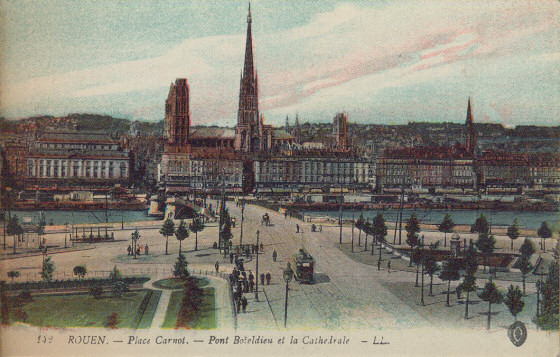
Boieldieu Bridge, with Rouen cathedral
beyond. This Boieldieu Bridge was destroyed in 1940.
- Pont Jeanne d’Arc - Joan of Arc Bridge, 1956;
- Pont
Guillaume le Conquérant - William the Conqueror Bridge,
1970;
- Pont Gustave-Flaubert, rising bridge, under construction.
There
is also a railway bridge, the Viaduc d’Eauplet, also called
Pont aux Anglais - Eauplet Viaduct/English Bridge, a little further
upstream. All of the completed bridges have been built (or
re-built) since the end of the Second
World War. The Boieldieu bridge, a transporter,
or suspended car, bridge and the Viaduc d’Eauplet were
destroyed by the French in 1940 in their attempts to slow the
invading German troops. Later, Rouen was served by several Bailey
bridges until the replacements could be built. The
transporter bridge at Rouen was opened in 1898 and destroyed on
9 June 1940. [French: pont transbordeur.] The nacelle,
or gondola, can be seen just above the water, beyond the steam
ship and towards the left of the picture. 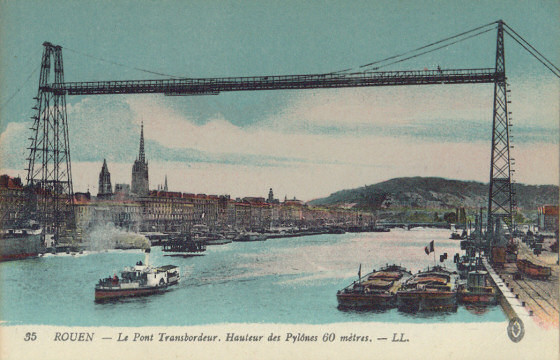
[Note:
Paris has 35 bridges!] Structural
statistics - 25 September 2008: Opening of bridge to
road traffic
- 15 April 2007 : bridge first raised for
water traffic
- June 2004 : Construction work started
- Expected
traffic: 55,000 vehicles a day
- The Pont Gustav Flaubert
links the exit of the A150 (motorway/autoroute
between Rouen and Barentin) and the Sud III ring road [rocade]
- RN 338, A13 (to the south of Rouen), A29 (to the northof Rouen).
- Architects : François Gillard; Aymeric
Zublena, architect of Stade de France and Istanbul Olympic Stadium
- Consultant
design engineer: Michel Virlogueux, architect of Pont de Normandie,
Millau viaduct,
the Ile de Ré
bridge, Vasco de Gama bridge in Lisbon, as well as the Stade
de France at Paris
- Structural conception : Bernard Gausset,
Michel Moussard
- Mechanical engineer : Jean-Pierre Ghilardi,
Eurodim
- Civil engineers : Eiffage Construction
- Metal
construction : Eiffel Construction Metallique and Victor Buyck
Steel Construction N.V.
- Foundations : Presspali France
- 86 m : Height at top of pylons (the heighest lifting
bridge in Europe)
- 7 m : Height of roadway over the Seine
when lowered (sufficient to allow barges)
- 55 m : Height
of roadway over the Seine when raised
- 670 m : Total length
of roadway including approach roads, makes the Gustav Flaubert
Bridge the longest lifting bridge in the world
- 116 m
: Length of mobile section
- 2600 tons : load capacity
- Length
of cables: 6 kilometres
- 30 to 40 times : predicted average
number of times roadway will be raised every year
- 12 minutes
: time to raise roadway
- Road traffic is diverted over
the Pont Guillaume le Conquérant during the 1½ hours
when the bridge is raised.
- 450 tonnes : Weight
of ‘butterfly’ pulley head
- 66 m : height
of ‘butterfly’ pulley head
- 1200 tonnes : weight
of each roadway. Counter-balances within the pylons reduces the
load lifted to only 350 tonnes.
- concrete and metal: construction
materials
- Won the national Grand prix for engineering
in 2006
- Won the Metal Construction prize in 2007
- 60 million euro : cost of bridge
- 137 million
euro : total project cost (includes approach roads)
- Financing
is shared -
state: 27.5%; region: 27.5%; department (Seine
Maritime): 35%; Rouen agglomeration: 10%
 |
Le pont Gustave Flaubert à Rouen
by
Jérôme Lallier
[text in French] Textuel,
2008
ISBN-10: 2845972520
ISBN-13: 978-2845972520 Jérôme
Lallier is a Rouen-born photographer, taking pictures of the Pont
Gustave Flaubert project since 2005. | end
notes
- The name of
the city of Rouen started life as Ratuma or Ratumacos, its Celtic
name. This was modified by the Romans into Rotomagus. Then further
changed into Rodomum by writers of medieval Latin. The modern
city name is a corruption of Rodomum.
-
Transporter bridge
- This type of bridge is also known as a suspended car
bridge, or ferry bridge, or aerial transfer bridge, the French
term is un pont transbordeur. Such a bridge has two tall
metal pylons with a horizontal travelway fixed high above the
river. A gondola is suspended from an electric shuttle that runs
along the travelway, providing transport across the river, while
still allowing sailing ship traffic. I am aware of at least twenty-two
transporter bridges built around the world, six being in France
[Bordeaux, Brest, Marseille, Nantes, Rochefort, Rouen, and a minature one at Montceau-les-Mines] and five
in the UK.
Eight transporter bridges are still used today,
though the one at Duluth, Minnesota in the USA, built in 1905,
was converted in 1930 into a traditional lift bridge. Functioning
transporter bridges include the Rochefort-Martrou Transporter
Bridge at Rochefort, Charente-Maritime in France, the Vizcaya
Bridge at Portugalete, North Spain, Newport and Middlesborough
in the United Kingdom, and two in Germany - at Rendsburg and Osten
(Oste).
The two US transporter bridges no longer exist
(well the Duluth does, but as an airial lift bridge). The other
US transporter bridge was built for the 1933 World Fair at Chicago
and was called the Sky Ride. It was more of a ride, with 12 double-decker
cabins called “Rocket Cars”, similar to those on the
London Eye. It was demolished in 1934. The first transporter bridge ever built was the Vizcaya Bridge in north-western Spain, completed in in 1893. It still
functions at Portugalete near Bilboa.
-
- There is a vertical lift bridge at Sacramento, California, called the Tower Bridge. It spans the Sacremento River at ‘M’ Street on Highway 40. The bridge was opened in 1935. Then, it cost $1 million and it was one of the highest lift bridges in the world. Like the Hoover Dam, this project created jobs during the Great Depression - in this case, 1,500.
The lift span weighs 2,300,000 pounds, counter balanced with an equal weight.
The lift span is 200 feet long and at flood stage it has 100 foot clearance.
The towers are 180 feet/55 metres high.
The lifting deck rises using only two electric-powered, one hundred horse power motors housed in cabins at the top of each of the towers. The deck can rise to the maximum height of 173 feet at a speed of 1 foot per second. This also allowed the towers to be parallel to each other, helping its streamlined look.
The bridge was beautified by the lift towers being sheathed in bolted and riveted quarter inch plate steel, so creating a streamlined effect. The counterweights were similarly treated. (This technique was later used on the San Francisco Oakland Bay Bridge.) The counterweights were hidden in concrete-filled steel frames. Thus, with much of the working parts concealed, the Tower Bridge had a sleek, aesthetically pleasing appearance.
Although this bridge was originally designed to have four road lanes and a central rail lane, it currently is only used for vehicles and pedestrians.
For decades, the bridge was painted silver, but there were continuing complaints of its glare. In 1975, the bridge was painted yellow ochre. The next colour chosen, by competition, was gold. Painted in 2002, it is to last 30 years.
- Bailey bridges
are prefabricated metal bridges invented and developed during
the 2nd World War by English engineer, Donald Bailey (1901-1985).
The parts are transported and assembled in place, more sections
being added if a wider water course has to be bridged. In Normandy,
about 1,000 Bailey bridges were built, mostly in conjunction with
the Allied D-Day invasion.
“[...] no part was
heavier than a 6 man load so small teams could carry on building
a bridge even under air attack and heavy gunfire. Crucial time
was saved by having the panels assembled on rollers. The first
part or nose was put together with the decking or roadway omitted.
The bridge proper was built on this nose and the whole was moved
forward on rollers as the panels were assembled. The Bailey bridge
was actually crossing the gap as it was being built.” [Quoted
from Stockport
Libraries.]
 Madame Bovary by Gustave Flaubert, 1821-1880
Madame Bovary by Gustave Flaubert, 1821-1880
$8.76
[amazon.com], 2005
£3.19
[amazon.co.uk], 2004 - paperback
ISBN-10: 0192840398
ISBN-13: 978-0192840394 |
advertising disclaimer
|








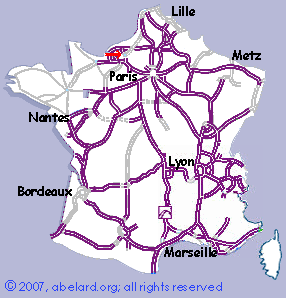
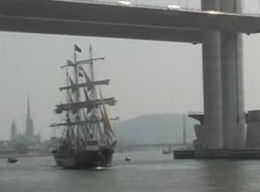











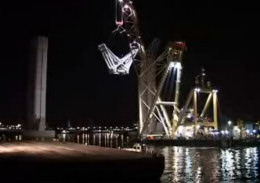
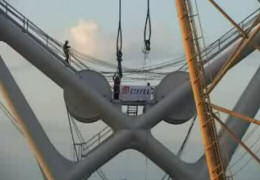
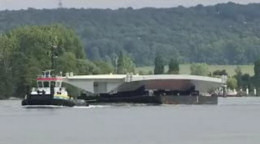
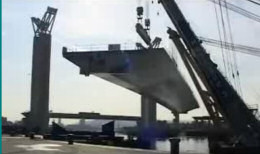
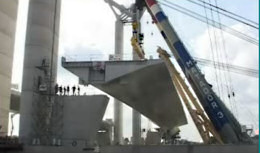
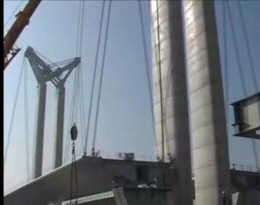

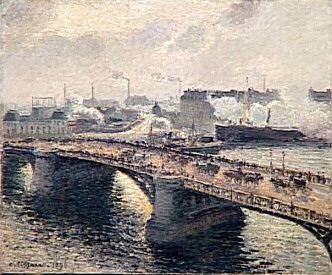
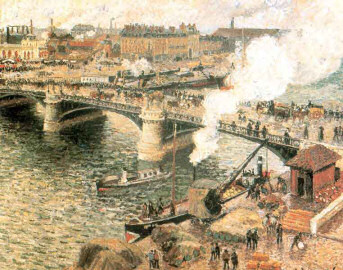



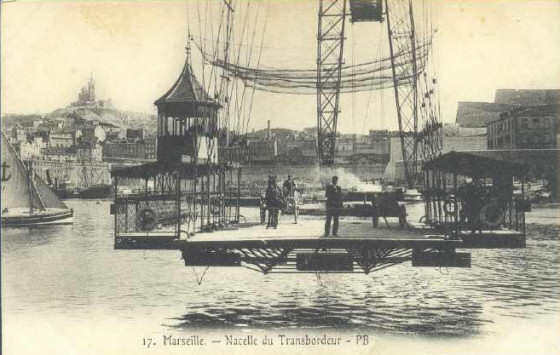
![Tower lift Bridge, Sacremento [linen postcard]](transborders/sacremento1.jpg)
